The next best thing to keeping a journal or writing a history of experiences of your life is to record an oral history of an event, period of your life, or an overview of your life. We have the rare and blessed opportunity to capture events and individual histories of leaders, Filipino saints, and missionaries. Often I stand opened mouthed amazed at some of the stories, events, and histories we’ve been able to record during oral history interviews. These interviews not only keep us humble, but inspire us. Here are a few summaries of the recent oral history interviews.
The Hansen’s – Cebu Mission Leaders
A few weeks ago, we had the opportunity to interview President and Sister Hansen who currently live in St. Louis, MO. The Hansen’s shared several experiences they had during their tenure as mission leaders in the Cebu Mission that might be of interest to you, they were to us.
At the time, the Cebu Mission encompassed the Cebu Island (an island that is 120 miles long and 20 miles wide) and five other islands. They traveled by pontoon plane, small boats, and ferries to the outer islands in the mission. The language spoken in Cebu is Cebuano. Filipino missionaries that are called to serve in the Cebu mission generally speak Tagalog but must learn Cebuano as do the foreign missionaries that are called to serve in Cebu. Nearly seventy-five percent of the missionaries serving in Cebu were native Filipinos and twenty percent of these were sister missionaries. The remaining twenty-five percent of missionaries serving in Cebu are foreigners (Americans, Aussies, Kiwis, Pacific Islanders, and a spattering from other nationalities).
During their tenure as mission leaders, the Cebu Temple was under construction. One of the challenges of building a temple in the Philippines are the high building standards that the church demands and finding craftsmen and contractors that could do this quality of work was a challenge. Often work completed had to be redone multiple times to meet the standards of construction required by the Church’s construction managers.
The Hansen’s shared that one of the miracles during the construction of the temple was the number of rainy days were at an all-time low allowing the temple to be built ahead of schedule.
During the time the temple was under construction, members saved for years to be able to travel and attend the temple when it would open. Some of the more creative ways of saving to travel to the temple was by limiting the family’s meals to two meals (often to one) per day and saving and setting aside the money from the third meal (not eaten meal) into a temple trip fund. During the open house that was held prior to the Cebu Temple dedication in 2010, there was a mile long line of Filipinos waiting every day for a month prior to its dedication to tour the temple. This is just a glimpse of the excitement surrounding having a temple within their part of the Philippines.
Given that many Filipinos live in poverty and their circumstances are humble at best, entering the temple and seeing the grandeur of the ordinance rooms and especially the celestial room is not only overwhelming for these faithful Filippino saints but also inspiring of the possibilities of a post-life existence.
There were several stories shared during this interview One story was of a sister missionary who was the youngest of ten children. Her mother passed away while she was serving her mission. When Sister Hansen, who was in shambles and in tears, as she attempted to tell this young missionary of her mother’s passing, this young sister missionary lovingly put her arms around Sister Hansen and told her, “Things will be okay, I’m a covenant child” – referencing the fact that her family had been sealed together in the temple for time and all eternity. Having an eternal perspective offers these Filipino saints comfort in trying times.
Three other missionary’s had parents pass away while serving – Filipinos have a much shorter life span than Americans do. Often the extended family demands that a missionary return home to assist with the caring of family members which is a cultural norm. All of these missionaries chose to remain on their missions.
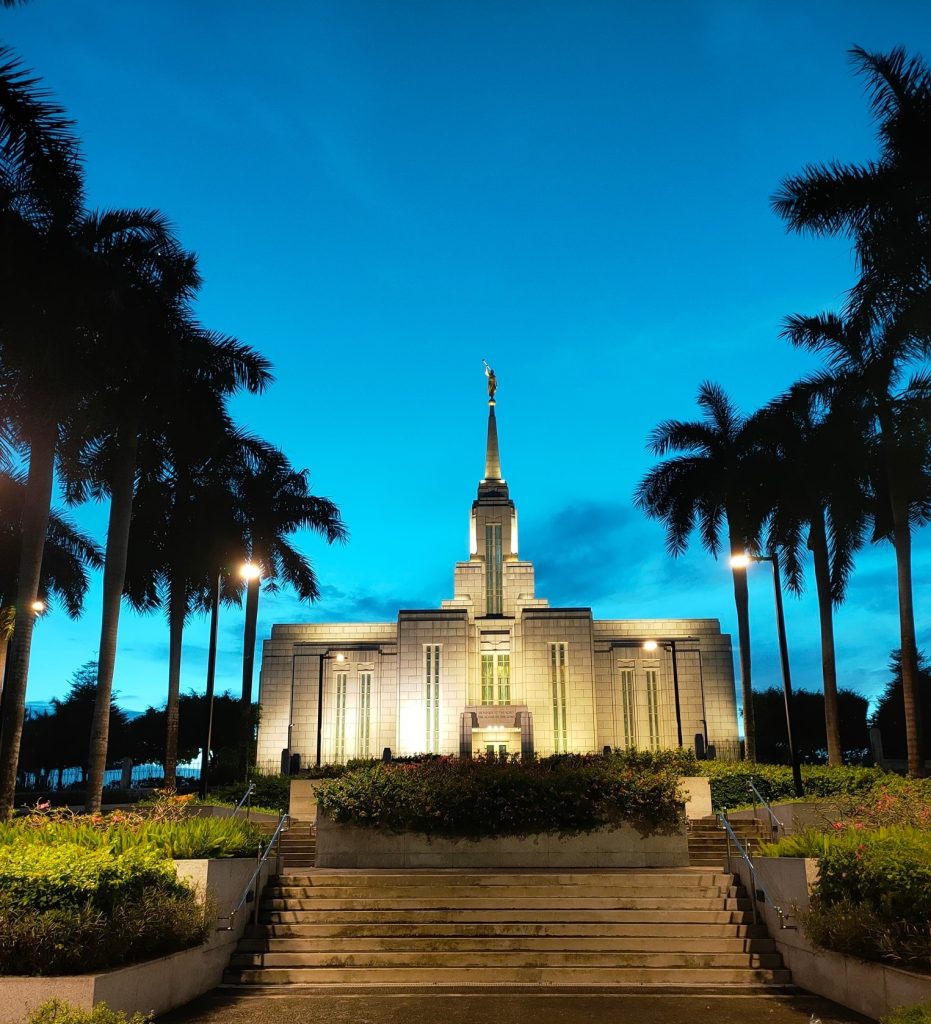
Cebu Temple in the Early Evening

Cebu Temple Entry Way

Cebu Temple Sealing Room

Cebu Temple Celestial Room
As you see these pictures of the Cebu temple, for a moment pretend that you are a Filipino family of humble means entering a temple of the Lord and seeing the symbolic splendor of the possibility of what the future holds for the faithful. The dedication and faithfulness of members that live in the general area of a temple is higher than those that have never seen or experienced being in a temple.
Other inspirational stories shared during the interview, were of how many members would walk two to three hours to church (because they didn’t have the few pesos to pay for a Trike or Jeepney ride) and then walk back home after church services never complaining of this hardship.
Challenges of Missionary Work
When discussing some of the challenges of missionary work in the Philippines, these mission leaders shared that because of the general poverty of the Filipino members, tithing is often a challenge. Yet, most faithful members paid a full tithe often at great sacrifice – yet they see it as a blessing.
Another issue for new Filipino converts to the gospel of Jesus Christ is because of the fact that most were Catholic and several generations of their family had burial crypts in Catholic cemeteries. Because of this, there was often a concern about where they will be buried when they pass away because often the Catholic clergy would preclude non-Catholic burials in the church’s cemetery. Since families view that being buried with your family is such a core cultural component in the Philippines, the “where will I be buried” issue causes many Filipinos to carefully consider their baptism. Some of the aleination from Catholic circle of friends causes some to decide not to move forward with being baptized.
Mission Mom and Nurse
Sister Hansen shared how she learned to be a quasi-registered nurse being the defacto first line of medical care for nearly two hundred missionaries. She learned to give shots and maintained a small pharmacy of medicines for the missionaries since there were often no pharmacies near where the missionaries lived. Because she had seven children, she generally knew when someone needed to go see a doctor.
Since the Philippines has a Christian foundation and background, Filipinos loved their Bible and quickly learned to love the Book of Mormon as well. The Hansen’s shared a story of a member that lived in a remote island and hadn’t had contact with members of the Church for over twelve years; however, he had his Book of Mormon which he read daily, often by candlelight. Because the main theme of the Book of Mormon is Christ, his faith never wavered.
Dinner with Special Missionaries
I’ve shared with you several times how I’ve randomly bumped into Elder Aaron Bliss, a missionary from our home town in El Dorado Hills, CA. After bumping into him again a few weeks ago just outside of our local Barangay near we we live and then sharing my chance meeting with Elder Bliss and his missionary companion, on one of my evening walks, Marcia immediately called the Quezon City Mission Home/Office to get his phone number and invited him and his companion over for dinner at our humble apartment.
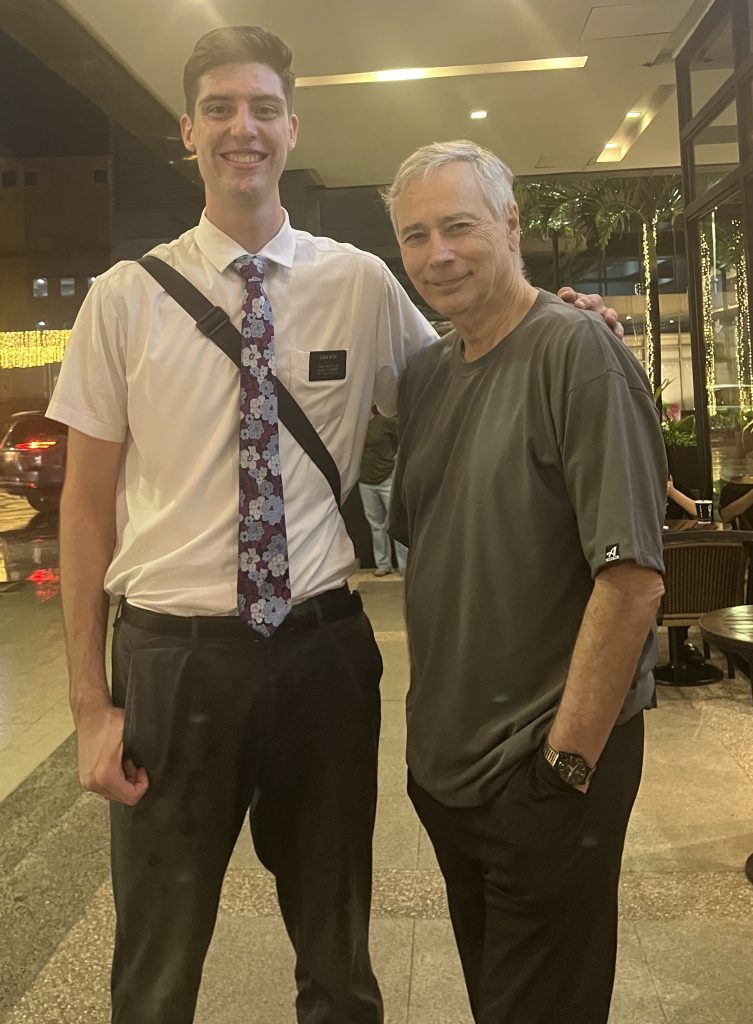
Bumping into Elder Bliss as he was walking home through Eastwood City (where we live) on a Sunday evening
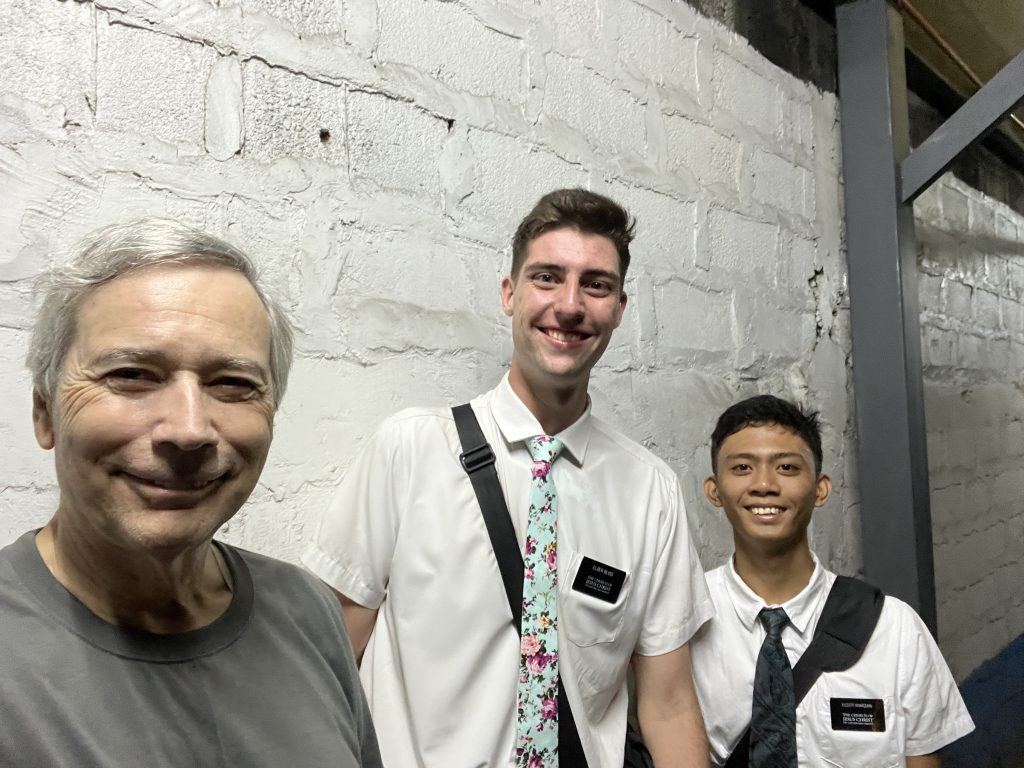
Elder Bliss and his companion (who had been on his mission for four days) bumped into me on one of my evening walks
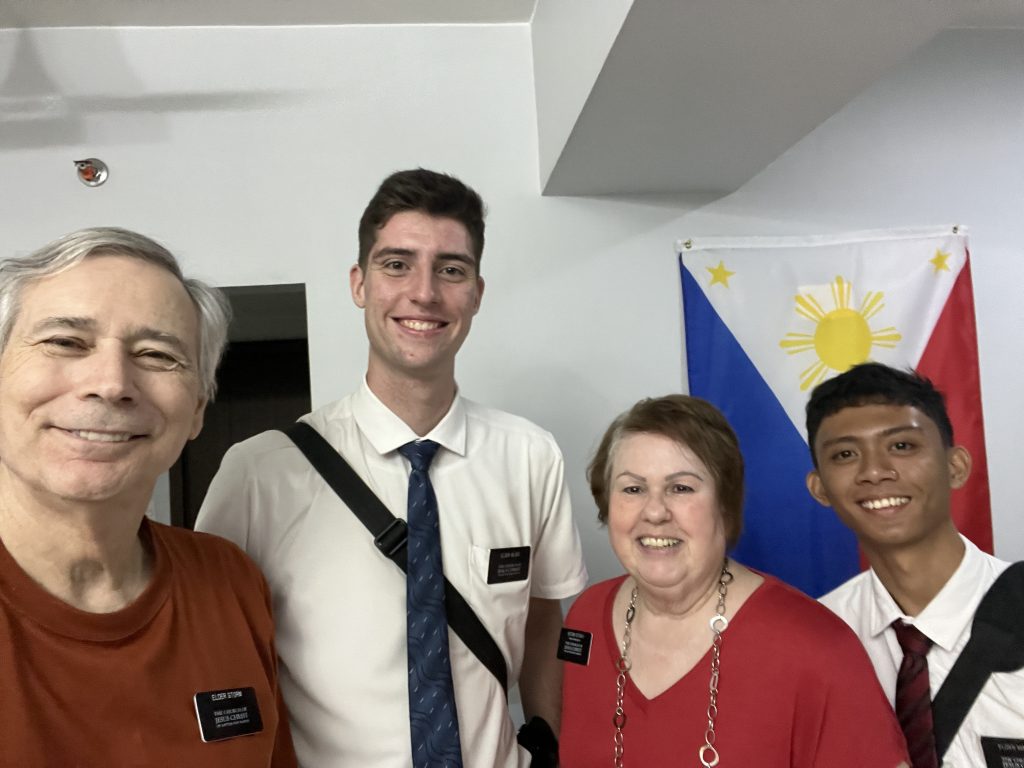
The missionaries at our home after a gourmet chicken and rice dinner prepared by Master Chef Marcia
Things I continue to learn about the Philippines….
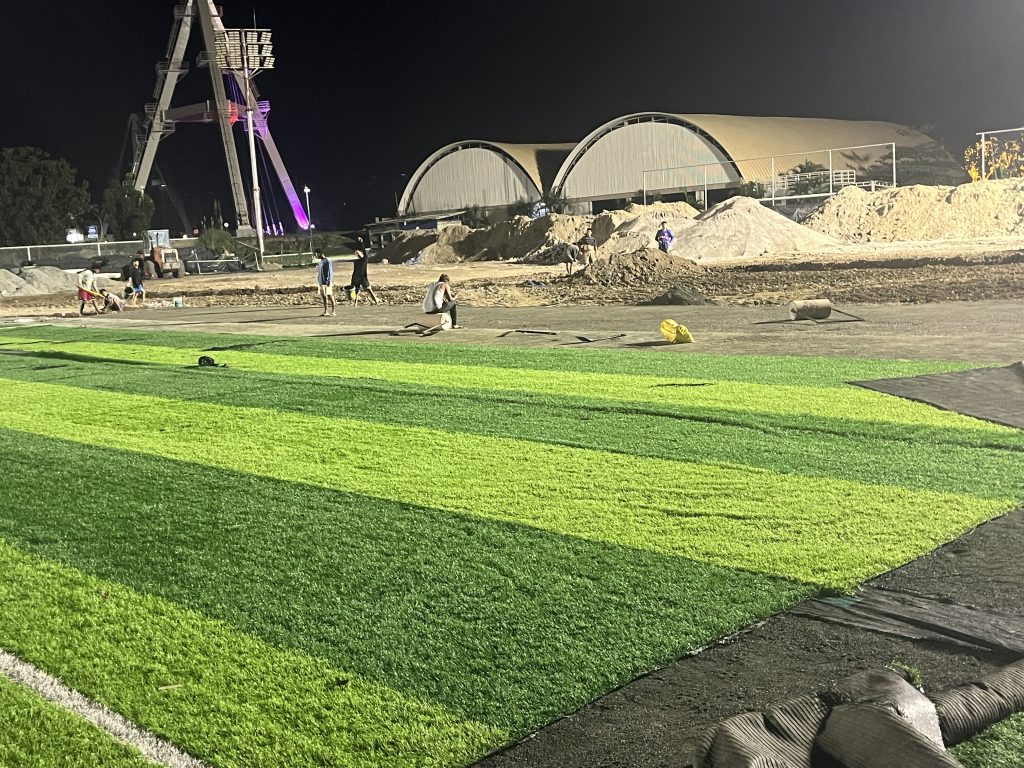
Laborers works 10+ hours during the day and another crew takes over for 10+ hours to work the night shift
I walk for several miles each evening or in the early morning. The other night I was walking by a condominium community. There was a soccer field that was being upgraded with new artificial turf and a rather sophisticated drainage system. I had been walking by this field for a few weeks. As I walked by the soccer field on this evening, the ground (prior to laying the actual artificial turf) was being prepared for more artificial turf to be laid.
In other countries, a soccer field ground might be leveled and prepared for the laying of the turf with a front end loader tractor. Here in the Philippines at this soccer field, there were laborers working using buckets to carry dirt from piles of new dirt across the field and dumping it and then leveling out the dirt by hand. Since labor is not an expensive component of a construction job in the Philippines like it might be in other countries, many projects like this is less expensive to have people do much of the work rather than using machines.
Thought for the day: Coincidences are God’s way of remaining anonymous.
Scriptural Thought: Thou shall be favored of the Lord because thou hast not murmured. 1 Ne 3:6
